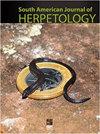Sexual Identification of Caiman latirostris Hatchlings by Cloacal Inspection
IF 0.7
4区 生物学
Q4 ZOOLOGY
引用次数: 4
Abstract
Abstract. Sexual identification of crocodilians is important in population studies and provides useful information for conservation and management plans and monitoring populations over time. It is possible to distinguish between male and female Caiman latirostris by cloacal palpation or eversion of the penis in individuals larger than 75 cm total length, but smaller animals possess a barely differentiable cliteropenis. In hatchlings, sex determination methods involve surgical examination, necropsy, or analysis of cranial dimorphism, which cannot be applied in the field. We classified hatchlings of C. latirostris by observing the color and shape of their genitals. The penis is a milky white organ with a rounded shape at the tip and a purple hue at the end, whereas the clitoris is shorter, whitish, and has a pointed end. The procedure was tested on hatchlings from three nests at the “Proyecto Yacaré” study area (Santa Fe province); half of the eggs of each nest were incubated at a constant temperature of 31°C (producing females) and the other half at 33°C (producing males). To observe the sexual organs by cloacal inspection, we used a modified instrument whose function during palpation is like that of a finger applied in large animals to evert the penis or clitoris. In the first days after hatching we correctly scored the sex of 80% of the individuals. The number of correct identifications was slightly lower for males than for females. This technique might be a useful tool for field studies, as it allows the sex of small caimans to be estimated in situ.用阴沟检查法鉴定Caiman latirostris孵化后代的性别
摘要鳄鱼的性别鉴定在种群研究中很重要,并为保护和管理计划以及长期监测种群提供有用的信息。在总长度超过75厘米的凯门鳄中,可以通过触诊或阴茎外翻来区分雄性和雌性,但较小的凯门鳄几乎无法区分阴蒂。在雏鸟中,性别确定方法涉及手术检查、尸检或颅骨二态性分析,这些方法不能在野外应用。我们通过观察其生殖器官的颜色和形状来对幼鱼进行分类。阴茎是一个乳白色的器官,顶端呈圆形,末端呈紫色,而阴蒂则较短,呈白色,末端呈尖状。该程序在圣达菲省“Proyecto yacar”研究区域的三个巢的雏鸟上进行了测试;每窝一半卵在恒温31℃下孵化(产雌),另一半卵在恒温33℃下孵化(产雄)。我们使用了一种改良的仪器,在触诊过程中,它的功能类似于大型动物的手指来检查阴茎或阴蒂。在孵化后的第一天,我们对80%的个体的性别进行了正确的评分。男性的正确识别率略低于女性。这项技术可能是实地研究的有用工具,因为它可以在现场估计小型凯门鳄的性别。
本文章由计算机程序翻译,如有差异,请以英文原文为准。
求助全文
约1分钟内获得全文
求助全文
来源期刊
CiteScore
1.50
自引率
0.00%
发文量
10
期刊介绍:
The South American Journal of Herpetology (SAJH) is an international journal published by the Brazilian Society of Herpetology that aims to provide an effective medium of communication for the international herpetological community. SAJH publishes peer-reviewed original contributions on all subjects related to the biology of amphibians and reptiles, including descriptive, comparative, inferential, and experimental studies and taxa from anywhere in the world, as well as theoretical studies that explore principles and methods.

 求助内容:
求助内容: 应助结果提醒方式:
应助结果提醒方式:


